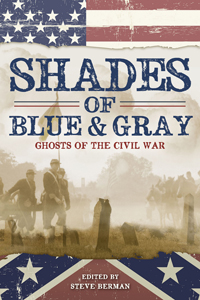 “Are these things real? Did they happen? Are they being enacted today? Or are they the fancies of the imagination in forgetful reverie?” —Private Sam Watkins Co. H 1st Tennessee Volunteers
“Are these things real? Did they happen? Are they being enacted today? Or are they the fancies of the imagination in forgetful reverie?” —Private Sam Watkins Co. H 1st Tennessee Volunteers
“Everyone has his superstitions.” —Ulysses S. Grant
Introduction to Shades of Blue & Gray: Ghosts of the Civil War
Homer tells that spilt blood allowed the shades of the Underworld to speak. Is this why no other event in American history haunts the nation so deeply as the Civil War? So many books have been written—by academics, by folklorists, by amateur historians—on the events spanning April 12th, 1861, when Confederate forces fired upon Fort Sumter in South Carolina, to, almost four years later, Robert E. Lee’s surrender to a modern Odysseus, Ulysses S. Grant, at Appomattox Court House in Virginia on April 9, 1865. It is estimated that the brutal war consumed nearly a million men, mostly soldiers, but the toll on civilians will never be truly known. Miles of the American landscape, be they farmland, town, or city streets, turned barren from the cruel caress of artillery shell, of bloodshed, of being set ablaze by the victors. The wounds scarred over, became resentment and monument. And became ghosts that lurked at the fringes of memory and memorial.
At every historical park that had seen a battle during the War, in small towns across America, possess legends of spectral soldiers, their kith and kin that waited for the men to return even if it meant staying on the face of the earth long after their remains were interred, of musket and cannon and screams that echoed long after decades had rusted metal and rendered the work of Minié and Gorgas into harmless footnotes.
Curious tourists, visiting sites of unimaginable carnage where green grass now grows over fields once turned muddy with spilt blood and bronze statues stand silent witness, regularly purchase paperback books of these legends, these ghost stories. All purported to be true, of course.
What of the stories that follow the pages of this introduction? Despite fiction’s promise to tell only the most captivating of lies, is there no kernel of truth in the work of these twenty-one authors? Yes, there was a C.S.S. Huntley, a doomed submersible, and its tale is a terrible one. Yes, a brazen band of Confederates did cross the United Provinces of Canada’s border to raid a small town in Vermont. Yes, among the casualties were kind mistresses and cruel masters. So perhaps these ghost stories are more akin to the truth than you, the reader, can imagine.
To return one last time to Homer, and his Iliad, consider his themes of fate, glory, and homecoming (nostos to the Greeks). All wartime stories must consider these elements: a soldier confronts the prospect of his own death, the name he makes for himself in battle as well as the consequences of taking lives and land, whether he can return home—and what will he find of home and himself if he does? The authors offer some clue, some answer to all of these. The spirits that they have summoned from the blood shed more than a hundred fifty years ago are ready to speak to you now.
Steve Berman
Spring 2013